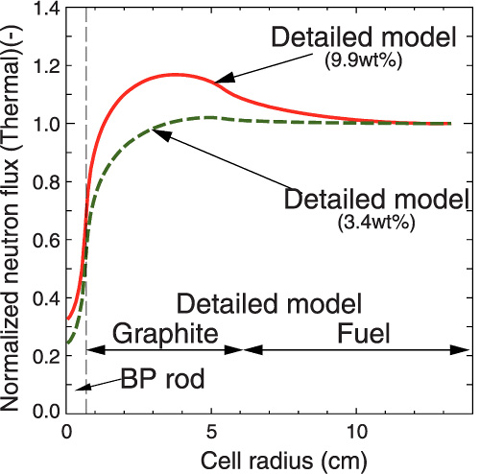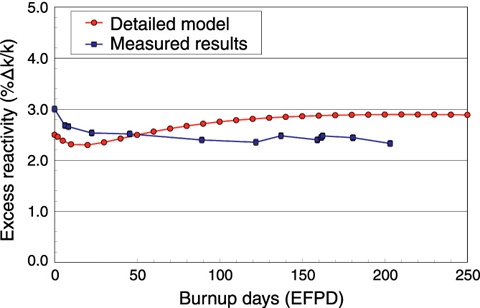
Fig.12-17 HTTR fuel block

Fig.12-18 Neutron flux distribution around BP rod

Fig.12-19 Comparison of measured and calculated excess reactivity
The High Temperature Gas-cooled Reactor (HTGR) is a proposed reactor type with high inherent safety features, with capability as a heat source, for hydrogen production, and for high efficiency power generation. The High Temperature Engineering Test reactor (HTTR) made by JAEA is the first HTGR in Japan. HTTR achieved the outlet coolant temperature of 950°C in 2004, which is the highest attained in the world.
The fuel block of HTTR is a hexagonal graphite block containing 33 fuel rods. The fuel block also contains two burnable poison (BP) rods at corners of the block. The HTTR core consists of 150 fuel blocks (Fig.12-17).
In HTTR, control rod position should be kept constant during one burnup period (660 days) keeping the profile of power distribution in the core which will achieve outlet coolant temperature of 950°C while keeping fuel temperature below its allowable limit. The change in reactivity during burnup should be compensated for by the BPs. Therefore, it is important to evaluate the burnup characteristics of BP for "HTTR" operation.
From the results of criticality tests, it was clear that the excess reactivity was less than the predicted value. To improve the prediction accuracy, improvement of calculation model was carried out. In the improvement, a detailed BP cell model (hereafter "the detailed model" ) was developed. In the model, a BP rod is located in a graphite region which is surrounded by fuel. The configuration of the detailed model corresponds to the actual configuration of the BPs in a fuel block. The model could reproduce the change in neutron flux distribution around a BP rod with different uranium-235 ( 235U) enrichments. The graphite enhances the BP reactivity effect of the 235U enrichment (Fig.12-18). The detailed model could evaluate BP reactivity which varies with change in fuel enrichment. Excess reactivity of the HTTR also was evaluated more precisely.
The detailed model was modified to include burnup calculations, because the neutron flux distribution around the BP rod changed with burnup. The model calculated a constant excess reactivity during the burnup period. The discrepancy between the calculated and measured results was small (Fig.12-19). It was clear that the detailed model could reproduce BP reactivity change with burnup precisely. Moreover, axial power distribution in the core was evaluated more precisely by the detailed model.
It was concluded that the detailed model could evaluate core characteristics under high burnup conditions. The detailed model can contribute to improve fuel economy of HTGRs. The model can be improved by experimental data under high burnup conditions.